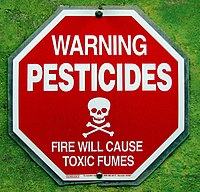
Photo from wikipedia
Pesticides and biocides (PaB) are ubiquitously present in aquatic ecosystems due to their widespread application and have been detected in rivers at concentrations that may cause distress to aquatic life.… Click to show full abstract
Pesticides and biocides (PaB) are ubiquitously present in aquatic ecosystems due to their widespread application and have been detected in rivers at concentrations that may cause distress to aquatic life. Many of these compounds accumulate in sediments acting as long-term source for aquatic ecosystems. However, data on sediment contamination with current-use PaB in Europe are scarce. Thus, in this study, we elucidated PaB patterns and associated risks in sediments of seven major European rivers focusing on their last stretch as an integrative sink of particles transported by these rivers. Sediments were extracted with pressurized liquid extraction (PLE) using a broad-spectrum method recovering many compound classes with a wide range of physicochemical properties. Altogether 126 compounds were analyzed and 81 of them were detected with LC-HRMS and GC-NCI-MS/MS at least in one of the sediments. The highest number of compounds was detected (59) in River Elbe sediments close to Cuxhaven with outstanding concentrations ranging from 0.8 to 1691 mg/g organic carbon. Multivariate analysis identified a cluster with 3 ubiquitous compounds (cyhalothrin, carbendazim, fenpropimorph) and three clusters of chemicals with higher variability within and between rivers. Risk assessment indicates an acute toxic risk to benthic crustaceans at all investigated sites with the pyrethroids tefluthrin and cyfluthrin together with the fungicide carbendazim as the main drivers. Risks to algae were driven at most sites almost exclusively by photosynthesis inhibitors with estuary-specific herbicide mixtures, while in the rivers Po and Gironde cell division inhibitors played an important role at some sites. Mixtures of specific concern have been defined and suggested for integration in future monitoring programs.
Journal Title: Environmental science & technology
Year Published: 2018
Link to full text (if available)
Share on Social Media: Sign Up to like & get
recommendations!